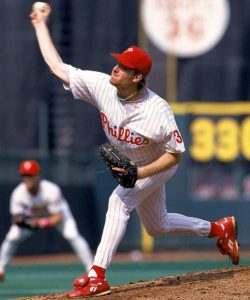

You had Darren Daulton at catcher, John Kruk manning first base, Dave Hollins pushing his way to the starting third base job, and Lenny Dysktra out in center field.
Tommy Greene remembers the clubhouse in ’92 was beginning to reflect the rowdy but immersed group of 1993.
“Our clubhouse with Dutch being a leader, and Kruk … it was sort of the same kind of clubhouse,” he said.
The team’s center fielder may have brushed some people the wrong way with his all-or-nothing style, but boy could he play.
“Lenny was Lenny. Lenny just hit,” said Greene. “He wasn’t a talker back then. Just hit.”
Hollins, 25 when the season began, finally had an opportunity to play everyday. He took advantage of it, showing patience at the plate with a hard-nosed, take-no-prisoners style on the field.
“David also changed when he was on the field. He was another dude,” Greene said. “But that’s the way he played the game.”
The clubhouse dynamic was set by that point. Daulton led with his mouth (and his play) while Kruk brought the fun. Dykstra showed by example what the Phils were about, while Hollins eased right in with the boys.
Reinforcements came before the season. The Phils brought in Mariano Duncan for 1992; regularly a second baseman, Duncan slid out to left field as the Phils gave 26-year-old Mickey Morandini more time to prove himself at second. Duncan, 29 at the time and previously with the Dodgers and Reds, was known as a professional hitter with a decent glove and a veteran presence. Sound familiar?
Duncan was beloved by his 1992 teammates.
“Mariano brought a smile to the clubhouse, but also a hard-working style, how to play the game right and with passion,” said Greene.
More role players would be added in 1992 and before the ’93 season, like Jim Eisenreich, Pete Incaviglia and former Phillie Milt Thompson, among others. And the same thing was happening on the mound. The ’92 team had obvious future pieces in Terry Mulholland, Greene and Curt Schilling, who the team acquired at the start of the season. The bullpen wasn’t quite together but received a major overhaul, as veterans like Larry Andersen and David West added the punch necessary to complete the staff.
The 1993 Phillies were so good in part because the ’92 Phils finished poorly. They had a decent Pythagorean record (78-84) and stayed in plenty of games, but there were obvious reasons 1992 didn’t work out – especially bad pitching and injuries. So the ’92 team learned from its mistakes and put their lessons into practice in ’93. That worked.
“It was about staying healthy and piecing it together, learning yourself a little bit more,” said Greene. “The current Phillies are doing that now. Those guys are getting that opportunity in the big leagues.”
Yeah, the current Phillies. We’ll have more on that later. But there’s a core developing. There are role players contributing to the dynamic. There are losses, but the team is learning how to turn those losses into wins.
Maybe 2017 won’t be like 1993; maybe it’ll be more like ’92. But maybe that isn’t so bad.
Just lay off the Budweiser cans and EMF cassettes, OK guys?